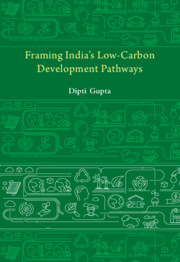Book contents
- Frontmatter
- Contents
- List of figures
- List of tables
- Prologue
- Acknowledgements
- List of abbreviations
- 1 Achieving Net Zero: A Wicked Problem for India
- 2 Themes for Exploring Low-Carbon Pathways
- 3 Building a Hybrid Dataset for Modelling Low-Carbon Pathway
- 4 Bottom-Up Approach and Technology Details
- 5 Macroeconomic Framing of Energy Systems in India Using Simulations
- 6 Top-Down Approach: Multi-Sector Economy-Wide Model
- 7 Scenario Construction and Pathways Analysis
- 8 Sectoral Case Study: Application of Hybrid Approach to Economy-Wide Analysis
- 9 Sectoral Case Study: Application of the Hybrid Modelling Approach to the Transport Sector
- 10 Conclusion: Other Applications, Policy Insights, and Road Ahead
- Index
10 - Conclusion: Other Applications, Policy Insights, and Road Ahead
Published online by Cambridge University Press: 15 July 2025
- Frontmatter
- Contents
- List of figures
- List of tables
- Prologue
- Acknowledgements
- List of abbreviations
- 1 Achieving Net Zero: A Wicked Problem for India
- 2 Themes for Exploring Low-Carbon Pathways
- 3 Building a Hybrid Dataset for Modelling Low-Carbon Pathway
- 4 Bottom-Up Approach and Technology Details
- 5 Macroeconomic Framing of Energy Systems in India Using Simulations
- 6 Top-Down Approach: Multi-Sector Economy-Wide Model
- 7 Scenario Construction and Pathways Analysis
- 8 Sectoral Case Study: Application of Hybrid Approach to Economy-Wide Analysis
- 9 Sectoral Case Study: Application of the Hybrid Modelling Approach to the Transport Sector
- 10 Conclusion: Other Applications, Policy Insights, and Road Ahead
- Index
Summary
Introduction
This book aims to contribute to the EEE modelling resources in terms of the methodological approach, policy analysis, and implications for decision-makers. Each chapter of the book explains each stage of the process of framing development and mitigation pathways for India. The AIM/Enduse and IMACLIM-IND models are developed and explained in this book to illustrate the approach to framing low-carbon development pathways; however, the approach is valid for soft-coupling in the case of other bottom-up and top-down models with meticulous consideration of inconsistencies and assumptions.
The hybrid IOT (see Chapter 3) for India is constructed using the recent national statistics of the Central Statistics Office, energy prices for each of the 22 sectors, and energy balance information from the IEA and bottom-up model. This method has no impact on policy analysis, as evident from the literature. Also, we set up a social accounting matrix with institutional agent disaggregation by collecting data from various sources for analysing the distribution of money among different agents.
The hybridization procedure involves extensive data treatment process with many steps. It uses supply–use tables and energy balance for this purpose. The IOT describes the sale and purchase relationships between the producers and consumers within an economy. Energy balance is the statistical accounting of the production, transformation, and consumption of energy products.
IOTs are often used for studying the links between decarbonization and sustainable development; however, the issue is that national accounts do not provide a complete description of energy systems. Since the energy balance provides a more reliable and disaggregated picture of energy systems, the IOTs of India need to be reconciled with energy balance using the energy prices for incorporating the energy systems description.
Information
- Type
- Chapter
- Information
- Framing India's Low Carbon Development Pathways , pp. 232 - 245Publisher: Cambridge University PressPrint publication year: 2025
